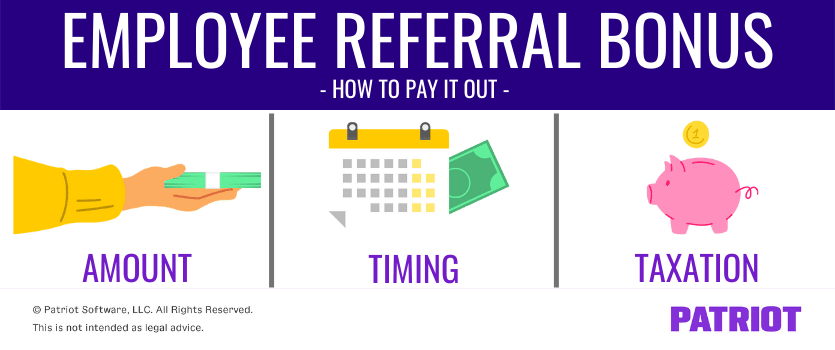Found the best new hire thanks to an employee referral? Great! Next on the agenda is paying out the referral bonus to the referring employee.
But, how you pay out referral bonuses depends on your policy. And before you cut that check (or click that button for direct deposit), you need to know the answer to: Are employee referral bonuses taxable?
Read on to learn:
- What is a referral bonus?
- Benefits of offering referral bonuses
- How to pay out a referral bonus
What is a referral bonus?
A referral bonus is a type of compensation employers give current employees who successfully help recruit new talent.
Here’s how it works: You establish an employee referral program. Employees can submit candidate recommendations. If you hire the employee’s referral, the referring employee receives a bonus.
So if you want to give employees opportunities to refer talent and receive bonuses, you need to:
- Create a system that lets employees easily submit candidate information
- Come up with a reward (e.g., $500 bonus)
- Put together a detailed plan for employees
- Notify employees about open positions and remind them of your bonus program
What kind of rewards do employers normally give employees who refer new talent that gets hired? For the purpose of this article, we’re talking about financial bonuses (i.e., bonus paycheck). But, that’s not the only kind of referral incentive you can offer. Non-financial referral bonus examples may include extra paid time off, praise and recognition, or prizes and awards.
Benefits of offering referral bonuses
Why should you source candidates your employees know? Consider the fact that individuals employees refer are 4X more likely to get hired. So, you may wind up liking the people your employees recruit for you.
And if you want to encourage employees to refer friends or colleagues, you may need to offer an employee referral bonus. According to Alex Milosh, Head of Organic Growth at Atera:
Giving bonuses for employee referrals is a great way to motivate your team and encourage them to help you find top talent. When deciding how much to give, consider the position being filled and the importance of making a good hire. You may also want to factor in the cost of other recruiting methods. For example, if I usually spend $1,000 on job board postings, I might give a $500 bonus for a referred hire that I wouldn’t have otherwise found.”
Incentivizing your employees to be brand ambassadors helps you:
- Find and recruit top talent
- Save your time and money (referrals save an average of over $7,500 per hire!)
- Source candidates who otherwise may not have applied
- Retain new hires
How to pay out a referral bonus
You’ve extended a job offer to someone one of your employees referred (hooray!). Next up is knowing how to pay out the referral bonus.
There are three main parts of paying out a referral bonus to keep in mind:
- Amount
- Timing
- Taxation

1. Amount
According to one study, the employee referral bonus average is $2,500. If you haven’t decided on an amount to pay for referrals, remember to do so before implementing your program.
How much you pay your employee in exchange for an employee referral depends on your program rules. So if you offer $500 for a successful candidate referral, $500 is the gross amount you need to pay the referring employee. The take-home amount may look a little different after taxes (which we’ll get to soon).
2. Timing
When do you pay the referring employee the bonus? And, do you pay one lump sum or split it into multiple payments? Your program rules should address and determine when you must dole out the bonus.
Take a look at some examples of when you might pay the referral bonus:
- Full amount after 90 days of employment
- Half of the bonus when the new hire starts and the other half after six months
Let’s take timing a step further. You also need to know the logistics of when you give the bonus pay. Do you want to wait and include it in the employee’s next scheduled paycheck? Or, do you want to give the bonus separately?
3. Taxation
An employee referral bonus is a type of supplemental wage. As such, referral bonuses—like regular wages—are subject to taxes.
When it comes to calculating federal income tax on supplemental wages, you can either:
- Withhold a flat 22% supplemental tax rate
- Add together the employee’s bonus and regular wages and withhold taxes on the combined amount according to IRS income tax withholding tables
Don’t forget to also withhold Social Security and Medicare taxes (as well as state and local taxes, if applicable).
Want to give the employee the full bonus amount? You can do a tax gross-up. This increases the total gross amount of compensation so that the amount after taxes is the full referral bonus amount.
The bottom line: Don’t cut that referral bonus check until you make sure to withhold all appropriate taxes.
This is not intended as legal advice; for more information, please click here.
